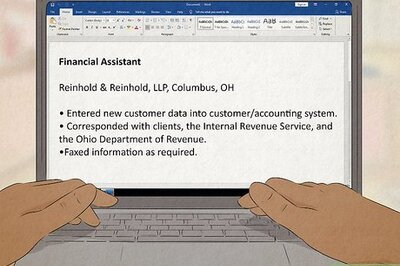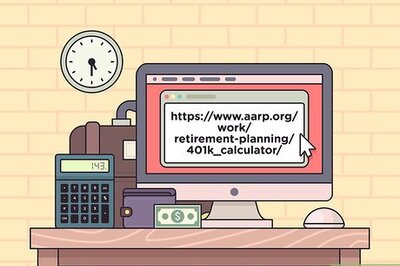
views
Learning the Basics of Serving

Know who can serve papers. If you are the petitioner—the party responsible for starting the case—you are not allowed to serve the papers. You must ask a third party who is unrelated to the case to do it for you. The individual serving the papers must be 18 years of age or older. The individual must not have a direct interest in the case. In other words, he or she cannot be the petitioner or part of the respondent. You can ask a friend, relative, co-worker, or anyone else you know if that individual meets these basic restrictions. This individual may need to be approved by the court beforehand, though. Alternatively, you can hire a professional to serve court papers, instead. You can usually find these professionals listed under "Process Servers" in a phone book or business directory. You can usually ask the sheriff, marshal, or constable to serve the court papers for a fee, as well.

Know who to serve. If you are suing one individual, you only need to serve that individual. If you are suing multiple individuals, you must serve each person you are suing. If you are suing a business partnership, serve one of the partners. Serve both partners only if you are suing the business and the partners separately. If you are suing a corporation, serve an officer of the corporation or their agent for service. If you are suing your landlord, serve the owner of the property you are renting. If you are suing the county, serve the county clerk. If you are suing the city, serve the city clerk. If you are suing the state, serve the Attorney General's office. The respondent must be in the state you file your petition in unless you are suing the owner of a property who lives outside of the state or the owner/driver of a car who lives outside of the state.

Serve the papers on time. The deadline for serving papers can vary by state, but usually, you must serve the papers to the respondent at least eight days before your court date. In some instances, you may need to serve the papers up to 30 days before the court date. For instance, if you serve papers using substituted service to someone outside of the county, you must do so at least 30 days before the court date. Check with the court when you file your petition to find out what your deadline is. Typically, papers can be served any day of the week except for Sunday. Petitions that include an order of protection can be served all seven days of the week and must be served 24 hours before a court date.

Locate the respondent. In most instances, there will be plenty of time in between the date you file your petition and your scheduled court date. If you do not already know where the respondent is, you will need to find that party yourself or hire a process server to do the job for you. If you are unable to find the respondent, you must give the judge a written list of all the methods you attempted to locate and serve the other party. Include as many details as possible, including dates and places you went to in an attempt to find the respondent. If you can prove that you have made every reasonable effort to serve the papers, the judge may set a new date for the case and ask you to try further, or he/she might give you permission to serve the papers in another way (mail, substitution, or publication).

Include all the necessary documents. When you file your petition, there are a few papers you will need to take with you when exiting the courthouse. These are the papers you need to serve to the respondent. A "summons" or "order to show cause" tells the respondent to appear at court on a certain date. You will also need to serve a copy of the petition you filed. If there has been a temporary order of any kind, that paper must also be served to the respondent. Note that you will receive a "Proof of Service" or "Affidavit of Service" form, as well, but this form will not be served.

Obtain and file a Proof of Service. A "Proof of Service" form is a legal document that shows the court that you did your duty in serving the papers correctly. This form must be filled out after you served the papers and submitted to the court before your case. An example of a "Proof of Service" form is here: http://www.courts.ca.gov/documents/pos020.pdf The form must include the location and date on which the papers were served. You must also indicate who the papers were served to and provide a physical description of that person. The name and address of the person who served the papers to the respondent must also be provided. Typically, this form must be notarized. The individual who served the papers must sign it in front of a notary public. The respondent does not need to sign the form, however. Give the original completed form to the judge when you go to court. Note that in some states, like California, you must file the form with the court at least five days before your court date. Keep a copy of the form for your own records, as well.
Conducting Personal Service

Find the person that needs to be served. Personal service requires you to know the more about the location and habits of the person you're serving than the others. Since most people don't like to be sued, they will delay dealing with a potential lawsuit as long as possible, and will go to great lengths to avoid service. It will save you time and money if you can tell your third-party service agent where the target of the lawsuit might be and when they might be there.

Pass the papers directly to the respondent. The server must give a copy of your court papers to the respondent in person. He or she must walk up to the respondent, state, "These are court papers," and hand the respondent copies of all the papers related to your case. The respondent may refuse to accept the papers. If this happens, the server should leave the papers near the respondent and walk away. Doing so will satisfy the requirements, even if the respondent continues to refuse the papers or throws them away. Personal service is the preferred method of service and should always be attempted before other methods are used.

Fill out a Proof of Service form. After passing the court papers to the respondent, the server should fill out the necessary form and sign it in front of a notary public. This form should then be filed with the rest of your court documents at the courthouse.
Learning the Details of Service by Mail

Pay the court clerk. In most states, you can pay the court clerk a small fee to mail the court papers to the respondent via certified mail or first-class mail, depending on which service is required for the type of papers being served. The fee you pay is usually low and can be recovered if you win the case. In some states, like California, service by mail must be made through the court clerk and you will be unable to mail the papers yourself. Check on your own state laws regarding this type of service to determine what the restrictions are.

Send the papers by certified mail. In some states, like Michigan or Arizona, you might be permitted to send the papers to the respondent without going through a court clerk. If this happens, those papers should be mailed via certified or registered mail, and you must request a return receipt. That receipt must be signed by the respondent to the petition. Note that certified mail is required when you are serving a paper that opens a case. If you are serving additional papers related to the case after that fact, you can usually opt for first-class mail.

File the Proof of Service form. If you pay the court clerk to send the papers, he or she must fill out the form. You will likely receive a copy and the court clerk will keep the original for the case records. If you live in a state that permits you to mail the papers yourself, you will need to fill out the form and file it as usual. Note that you will also need to include a copy of the signed receipt of delivery when filing the form with the court.

Understand the risks. Even though service by mail can be convenient, there is some chance that the judge will not accept this method of service unless strict guidelines are followed. In fact, roughly 50 percent of court papers served by certified mail are rejected. The judge must be able to read the signature on the certified mail receipt. That signature must belong to the respondent and no one else. If the respondent refuses to sign the certified mail receipt with his or her full name, that receipt cannot be accepted as proof of service.
Understanding Substituted Service

Know who else you can give the papers to. If the server has done all in his or her power to serve the papers directly to the respondent and has been unable to do so, your server can hand those papers over to a party that can legally accept them on the respondent's behalf. A competent adult, age 18 or older, who lives at home with the respondent can usually accept the papers. Similarly, an adult who appears to be in charge at the respondent's workplace or an adult who seems to be in charge where the person receives mail can usually accept the papers, as well.

Instruct the substitute. When passing the court papers to a substitute, your server must leave that substitute with specific instructions regarding what the papers are and what needs to be done with them. Make sure that the substitute knows that he or she is receiving court papers for a specific individual. The respondent must be named, and the substitute must be told to deliver the papers to the respondent. Get the substitute's name when you leave the papers. If the substitute refuses to provide a name, write down a thorough physical description of the substitute.

Mail another copy. When you serve papers by substitution, you must also mail another copy of all court papers by first-class mail. Address the package to the respondent. You need to send the papers to the same address the server left the papers at.

Fill out a Proof of Service form. Afterward, the server must fill out the "Proof of Service" form as usual. In addition to this form, a "Proof of Mailing (Substituted Service)" form must also be filled out by the server. Get both forms from the server after he or she fills them out. File them both together at the courthouse on or before your court date. Provide a postal receipt with your forms indicating that you sent a second copy of the papers through the mail.
Using Service by Publication

Use this as a last resort. Try personal service and service by substitution first. Service by publication can only be performed if you have a written court order giving you permission to use this method. This method of service is very rare. In all likelihood, you will only be permitted to use it if you have already tried to serve the papers in every other reasonable way possible without any success.

Get an Order for Publication. This is the name of the official court order permitting you to use this method of service. You must file an Application for Order for Publication of Summons and a statement of Declaration of Due Diligence to the court to obtain such an order. The declaration is simply a statement regarding the efforts already made to serve the respondent. Tell the judge everything you know about where the other party might be. If you can show the court that the other party cannot be found, even if you know where the respondent should be, the judge may consider your request. If the judge accepts your request, he or she will order the notice to be published in a newspaper the judge selects for the order.

Obtain a sworn statement from the newspaper. After the notice has been published in the newspaper for the amount of time specified by the judge, the papers are considered to be served. The newspaper will then need to provide a sworn statement stating that the publication has been made as directed.

Submit your Proof of Service form. You will still need to fill out and file this form with the court as usual. The court will attach the newspaper's sworn statement to the complete form, as well.




















Comments
0 comment